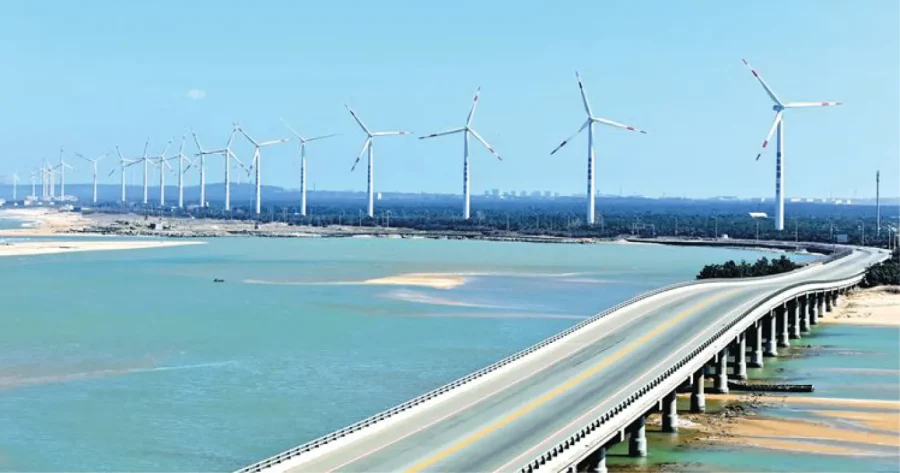Editor’s Note:
As China’s new-energy industry gains global pre-eminence, US officials have started a smear campaign based on the false “overcapacity” narrative. The rise of China’s new-energy sector is due to homegrown innovation and free market contest, rather than subsidies, and is beneficial for the world, instead of posing threats to other countries. To illustrate this, the Global Times is publishing a series under the theme of “New Energy, New Opportunities.” This story focuses on how the Chinese green industry draws its competitiveness from free competition, debunking the baseless claim that Chinese green strength stems from state subsidies. This is the last installment of the series.
Recently, Western politicians and media outlets have attempted to tie together China’s export of green products with a narrative around “overcapacity,” which is not only against the basic logic of economics, but also seriously inconsistent with facts. Against the backdrop of economic globalization, the key to determining whether there is “overcapacity” in related sectors is a combination of demand and future development potential for the global market.
Industry data has consistently shown that China’s exports of electric vehicles, lithium batteries and photovoltaic (PV) products have not only enhanced global supply, but also made great contributions to the global response to climate change and the transition to a green, low-carbon economy.
Meanwhile, the popularity of China’s new-energy products is the result of the private sector efforts, not government handouts. From over 20 years ago, Chinese enterprises have been investing in R&D and industrial efficiency in the field of new energy. While vigorously promoting the country’s development of clean energy, these enterprises contribute more Chinese technology, Chinese products and Chinese solutions to the world.
Chinese plan
“Without China’s [green] technology, products and solutions, few countries in the world would be able to afford to use new energy today, and those that are able to do so have been held back due to the high level of subsidies put in place by government, which are not sustainable over the long run,” Jinko Solar, a Chinese PV giant, said in a statement sent to the Global Times on Monday.
The company’s products have been sold across 190 countries and regions globally. One out of every eight PV modules in the world is manufactured by Jinko, which means that one out of every eight kilograms of carbon dioxide emission reduction provided by PV is contributed by the company.
In 2023, global renewable energy capacity increased by 50 percent compared to the previous year. Decarbonization is gaining momentum with a goal to triple renewable energy by 2030 during COP28.
During a special meeting held by World Economic Forum in April, Li Zhenguo, founder and president of another PV company LONGi, emphasized China’s role in the global new energy industry, citing the country’s significant contributions to PV installations.
In May, LONGi has broken another world-record for silicon solar cell efficiency of 27.3 percent under laboratory conditions.
According to a report from the International Renewable Energy Agency, global wind and PV power generation costs have decreased by over 60 percent and 80 percent over the past decade, respectively, largely attributed to Chinese innovation, manufacturing and engineering.
In addition to its push in renewable energy, China’s new-energy vehicle (NEV) producers also provided their Chinese plans to contribute to a global green transition. For instance, BYD announced last December the construction of a new-energy passenger car production base in Szeged, Hungary. The plant will be completed and put into operation in three years and will create thousands of local jobs and contribute to the green economic transformation of Hungary.
“As China strives to fulfill its low-carbon commitments, it continues to provide Chinese solutions for the world’s green transition. With the global green transition, the demand for new-energy products will continue to expand, and the country’s high-quality products are what the world needs most. The so-called overcapacity narrative is contrary to common sense,” Wang Peng, an associate research fellow at the Beijing Academy of Social Sciences, told the Global Times on Monday.
China’s new energy industry is a positive force, not a threat. The country’s high-quality new-energy products have enhanced global supply, promoted green and low-carbon process and helped realize the goals of the Paris Agreement, He Yadong, a spokesperson from China’s Ministry of Commerce, told a press conference on Thursday.
It is estimated that each NEV reduces carbon emission by about 1.66 tons per year, and China’s export of 1.2 million NEV in 2023 will reduce carbon emission by about 2 million tons per year, He said, noting that the development of China’s new energy industry promotes the widespread application and industrialization of green, digital and artificial intelligence technologies, adding new momentum to global economic development.
In addition, China’s new-energy products have obvious price advantages, making them more affordable for consumers and helping ease inflationary pressure. Overall, the country’s new energy industry has strongly contributed to the global green transformation, global technological and industrial progress, and the well-being of consumers around the world, He noted.
Debunking ‘overcapacity’ fallacy
“It is not ‘overcapacity’ but rather anxiety. Essentially, some countries are worried about their own competitiveness and market shares, and they use this as an excuse to discredit and suppress China, which is another new case of ‘double standards’ and trade protectionism,” He said.
This practice won’t stop the pace of China’s progress, but these countries will trip over themselves, and drag down the global economic recovery and green transformation, the spokesperson warned.
The implementation of green “double standards” will, on the contrary, undermine cooperation on climate change. Europe and the US hold up the banner of coping with climate change with one hand, and wield the green protectionist stick with the other; they demand that China takes greater responsibility for coping with climate change while impeding the free flow of green products from China. This is a typical “double standards,” He said.










